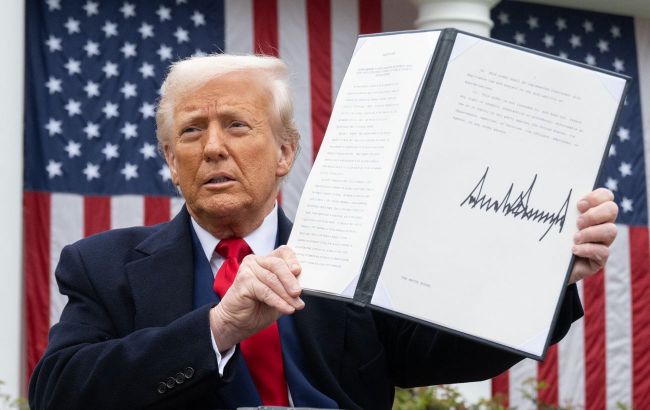Economic 'catastrophe'. How Trump's trade war hits global markets
 US President Donald Trump signs an executive order imposing tariffs (photo: Getty Images)
US President Donald Trump signs an executive order imposing tariffs (photo: Getty Images)
Donald Trump imposed tariffs on all US trade partners, including Ukraine. Politicians around the world criticized the American leader, warning of an economic catastrophe. Read about the potential consequences of trade protectionism below.
Contents
- Russia and Belarus will not be restricted
- Cars and computers
- Countries prepare countermeasures, but the US urges patience
- The end of globalization or an attempt to balance trade?
For the past few days, the whole world has been anticipating the new trade tariffs announced by the US president. On April 2, Donald Trump publicly signed documents stating that starting April 5, the US would apply a 10% tariff on all imported goods as a base rate. Ukraine was not exempt — this 10% tariff applies to it as well.
The Ukrainian government reacted calmly to the US decision. "What do the new U.S. tariffs mean for Ukraine? Challenging, but not critical," said Deputy Prime Minister Yulia Svyrydenko. She adds that Ukrainian exports to the US are currently small — $874 million worth of goods were supplied in 2024, of which $363 million stood for pig iron and $112 million - pipes. Meanwhile, Ukraine purchased $3.4 billion worth of goods from the US.
"Our tariffs on American goods are quite low — 10% on cars, 0% on coal and oil. So we still have a chance to negotiate different terms — the US statement clearly mentions this possibility," she noted. If the situation cannot be resolved, the tariff will mostly impact small manufacturers, the Deputy Prime Minister clarified. According to her, Ukraine has something to offer the US, and if the tariffs are fair, both sides will benefit.
Separate tariffs on imports from countries with significant trade deficits and tariffs over 20% on US goods will take effect on April 9. Previously, Trump had promised to implement reciprocal measures against these countries by imposing matching tariffs. However, in the end, the imposed tariffs turned out to be half of those applied to the US. For example, while China imposes a 67% tariff on US goods, the corresponding tariff will be 34%. Adding to the previously introduced 20% rate for China, the total rate will rise to 54%. For the EU, it will be 39%, with a corresponding 20% rate. Canada and Mexico had previously been subjected to 25% tariffs.
Following Trump's decision, global stocks plummeted, and the US dollar hit a six-month low as investors shifted funds into gold, bonds, and the yen. S&P 500 index futures fell by more than 3%, while Nasdaq 100 futures dropped 4%. Apple shares declined by 7%, reducing the company's market capitalization by more than $240 billion. Nvidia's stock value fell by 5.6%, or $153 billion.
Russia and Belarus will not be restricted
Russia and Belarus were not included in the list of countries subject to the new tariffs. Trade restrictions with them had already been introduced in April 2022 when the UІ revoked their "most-favored-nation" trade status due to Russia's invasion of Ukraine. According to UІ officials, trade with these countries has now ceased. "As for Russia and Belarus, we do not trade with them," said Treasury Secretary Scott Bessent.
There is no external trade data available for Russia for 2025. US-Russia trade declined significantly last year, totaling about $3.5 billion, with imports from Russia accounting for approximately $3 billion. These imports mainly consisted of fertilizers, platinum, turbojet engines, phosphates, and soybean meal. The US also imported candy from Russia, mostly chocolate, amounting to $2.6 million in 2024.
Trump is preparing separate sanctions against Russia and countries that purchase its oil.
Belarus's exports to the US in 2024 amounted to just over $30 million, including woodworking products, fertilizers, and metal products. A full list of the new tariffs by country is provided in the tables below.
New US tariffs (Source: x.com/whitehouse)
Trump's new tariffs will not affect all goods. Imports of energy resources and minerals unavailable in the US will be exempt.
The US expects that the increased tariffs will force countries to reconsider their trade policies. These tariffs will remain in effect until the US president deems that the economic threat from the targeted countries has diminished or been eliminated.
Cars and computers
A surprise move was the introduction of a special 25% tariff on computers, which had not been previously announced. These tariffs could impact Apple’s business. The same tariff rate has been imposed on cars and car parts. These tariffs will take effect on April 3. Within 90 days, the list may be expanded based on proposals from the American auto industry.
In 2023, the US imported cars worth $210.3 billion from 87 countries while exporting $63 billion worth of vehicles. The main suppliers were:
-
Mexico – $45 billion. Many manufacturers, including Ford, GM, Toyota, and Volkswagen, produce cars in Mexico and ship them to the US.
-
Japan – $40.9 billion. Toyota, Honda, Nissan, Mazda, and Subaru dominate this segment.
-
Canada – $34.9 billion. Many American-brand cars (GM and Chrysler) are assembled in Canada and then exported to the US.
-
South Korea – $31.3 billion. Hyundai, Kia, and Genesis.
-
Germany – $23.9 billion. BMW, Mercedes-Benz, Volkswagen, and Audi ship vehicles to the US both directly from Germany and through factories in other countries.
The automotive tariffs aim to boost domestic car production and encourage foreign companies to manufacture in the US, creating additional jobs.
Countries prepare countermeasures, but the US urges patience
The European Commission is already preparing countermeasures. “Our objective is a negotiated solution. But of course, if need be, we will protect our interests, our people, and our companies,” said EC President Ursula von der Leyen. She believes US tariffs are essentially a tax on consumers, fueling inflation and raising costs for American manufacturers, potentially leading to job losses.
French Prime Minister François Bayrou called Trump's new tariffs a “disaster” for the global economy and the US itself, arguing that they create "huge difficulties" for Europe. He criticized the US for betraying its allies and warned of "serious times" for Europe and the West.
Canadian Prime Minister Mark Carney stated that US actions would significantly alter global trade and harm the American economy. “President Trump has announced measures that will fundamentally change the international trade system,” he said. “These tariffs will negatively impact the US economy, and over time, this effect will grow.”
China sharply criticized Trump’s decision, stating that the US will not be able to intimidate them. “Intimidation doesn’t work on us. Pressure, coercion, or threats are the wrong way to deal with China. Those who apply maximum pressure on China are miscalculating,” the Chinese Foreign Ministry said. Beijing urged Washington to resolve issues through negotiations and has taken steps to limit investments in Chinese companies within the US, potentially gaining leverage in future talks.
Colombian President Gustavo Petro called the US tariffs a mistake, arguing that they mark the end of the era of global free trade. “The US government believes that by raising tariffs on all imports, it can increase domestic production, wealth, and employment. In my view, it could be a major mistake,” Petro said.
Brazil has pledged to defend its manufacturers, stating that the US tariffs violate WTO commitments. The Brazilian government pointed out that Washington’s actions contradict World Trade Organization rules.
The US is urging countries not to rush into retaliatory measures. Treasury Secretary Scott Bessent warned that countermeasures could escalate trade tensions. “Sit back, take a deep breath, don’t immediately retaliate. Let’s see where this goes, because if you retaliate, that’s how we get escalation,” he said.
The end of globalization or an attempt to balance trade?
Economist Oleksii Plotnikov believes the US is shifting toward strict protectionist measures. “This confirms that globalization is declining. If the COVID-19 crisis weakened globalization and the war in Ukraine stalled it, now we are seeing the fragmentation of the global economy. Now there are no global processes, no free trade, no dominant centers of influence, and entirely different rules,” Plotnikov told RBC-Ukraine.
He compared the situation to the post-World War II period when countries freely imposed tariffs on one another before the WTO and common markets existed.
Ukrainian economist and former presidential advisor Oleh Ustenko warned that US tariffs would impact both its partners and the US itself. “The more barriers you have in international trade, the worse your domestic market will perform. That’s what Robert Lawrence, a renowned American economist, taught — and Trump once cited him as an icon for economic decision-making,” Ustenko said in a comment to RBC-Ukraine.
In the medium and long term, Ustenko predicts that Trump’s tariffs will have a negative impact on the US economy. “The US is a massive economy, so any trade restrictions it imposes will affect all its partners, whether they trade directly with the US or indirectly. At home, these restrictions will drive up domestic prices,” he noted. Rising prices will contribute to inflation, potentially eroding real incomes.
If other countries retaliate, it could destabilize global trade and worsen their own situations. “They won’t be able to replace these goods in the short- or medium-term and will face an inflationary surge. This will affect not just the US but everyone connected to its economy,” Ustenko explained.
He also warned of broader consequences. “When inflation rises and restrictions are imposed, you can’t expect economic growth to meet expectations. Potential declines in growth could lead to financial problems, budget issues, and difficulties in funding social programs,” he said.
Ustenko doubts that Trump is unaware of the risks of such drastic measures. He suggested that the US may be using tariffs as a pressure tactic to achieve strategic goals. “Trump may continue using tariff policy as a card he plays at key moments to achieve political and geopolitical objectives,” he said.
For now, Trump’s primary economic goal remains balancing trade to an optimal level. The US’s willingness to negotiate on tariffs with partners suggests that the situation may stabilize in the near future, preventing severe disruption to global trade.

